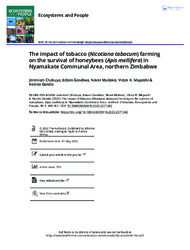| dc.contributor.author | Chakuya, Jeremiah | |
| dc.contributor.author | Gandiwa, Edson | |
| dc.contributor.author | Muboko, Never | |
| dc.contributor.author | Muposhi, Victor K. | |
| dc.contributor.author | Gondo, Reniko | |
| dc.date.accessioned | 2022-10-11T17:05:48Z | |
| dc.date.available | 2022-10-11T17:05:48Z | |
| dc.date.issued | 2022-05-31 | |
| dc.identifier.citation | Chakuya, J., Gandiwa, E., Muboko, N., Muposhi, V. K., & Gondo, R. (2022). The impact of tobacco (Nicotiana tabacum) farming on the survival of honeybees (Apis mellifera) in Nyamakate Communal Area, northern Zimbabwe. Ecosystems and People, 18(1), 348-357. | en_US |
| dc.identifier.issn | 26395908 | |
| dc.identifier.uri | 10.1080/26395916.2022.2071342 | |
| dc.identifier.uri | https://www.tandfonline.com/ | |
| dc.identifier.uri | https://hdl.handle.net/13049/548 | |
| dc.description | Gold Open Access | en_US |
| dc.description.abstract | The impact of tobacco (Nicotiana tabacum) farming on the survival of honeybees (Apis mellifera) was investigated through the documentation of mortality of honeybees, the number of trees cut and planted, and agrochemicals used in tobacco farming in Nyamakate Communal Area, Hurungwe District, northern Zimbabwe. The study was conducted in the wet season, i.e. between December 2017 and March 2018 using a stratified random sampling design to sample tobacco farmers and apiculturists. Honeybee mortalities across five sampled villages were significantly different (Kruskal–Wallis χ2 test = 74.54, df = 4, p < 0.05). The survey recorded 14 different agrochemicals that tobacco farmers used in tobacco farming, although the local regulator banned five of them in the 2018 and 2019 agriculture season. All five villages recorded an estimated 5,220 indigenous trees that were cut to cure tobacco whereas 483 Eucalyptus trees were planted as part of ongoing reforestation efforts in the district within the study period. It was concluded that tobacco farming negatively impacts honeybees through reduced forage and nesting sites (resulting from deforestation) and increased mortalities from the use of toxic agro-chemicals. There is a need for legislative alignment to ensure effective law enforcement on compliance. Government and partners need to encourage tobacco farmers to plant fast-growing indigenous trees for afforestation and adopt modern technology such as the use of solar-powered tobacco curing barns. | en_US |
| dc.language.iso | en | en_US |
| dc.publisher | Taylor & Francis Online | en_US |
| dc.relation.ispartofseries | Ecosystems and People;18(1), 348-357 | |
| dc.subject | Conservation | en_US |
| dc.subject | Graciela Rusch | en_US |
| dc.subject | Habitat | en_US |
| dc.subject | Honeybees | en_US |
| dc.subject | Natural resources | en_US |
| dc.subject | Tobacco farming | en_US |
| dc.title | The impact of tobacco (Nicotiana tabacum) farming on the survival of honeybees (Apis mellifera) in Nyamakate Communal Area, northern Zimbabwe. | en_US |
| dc.type | Article | en_US |

